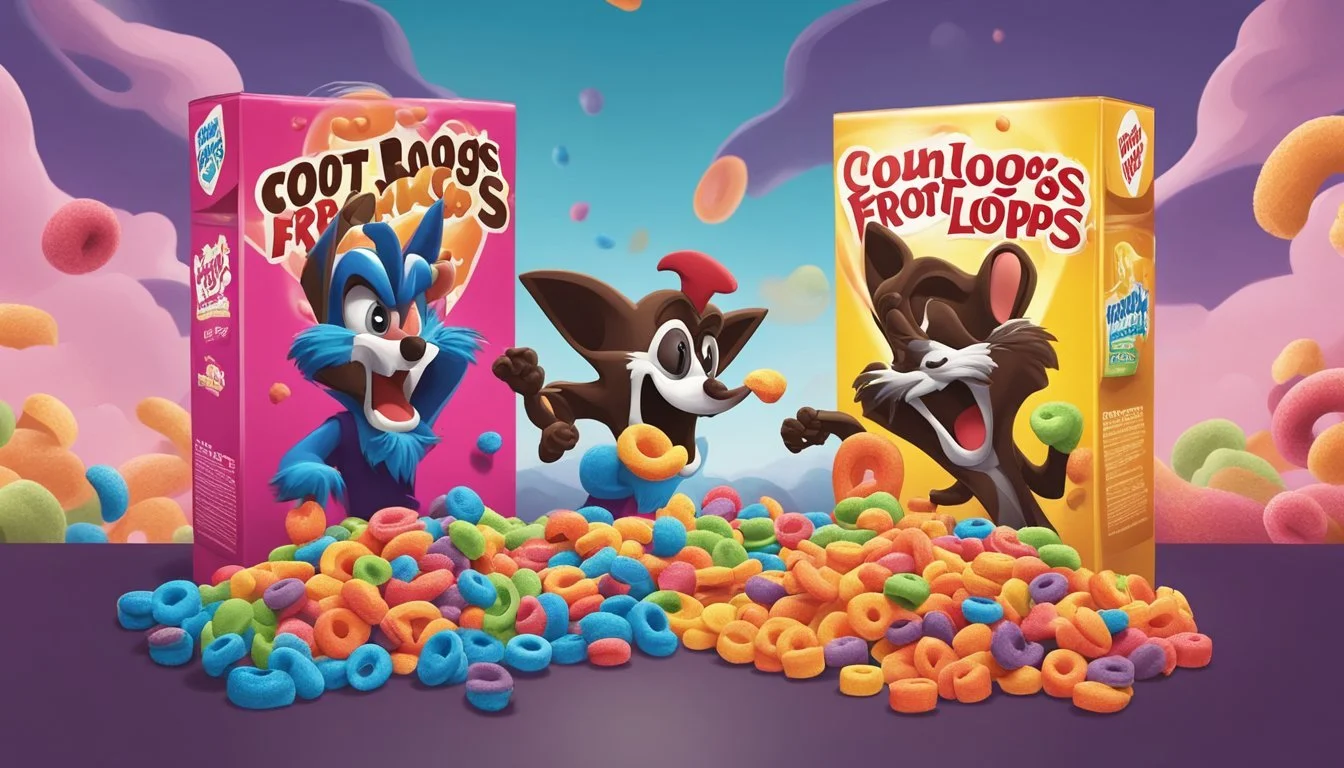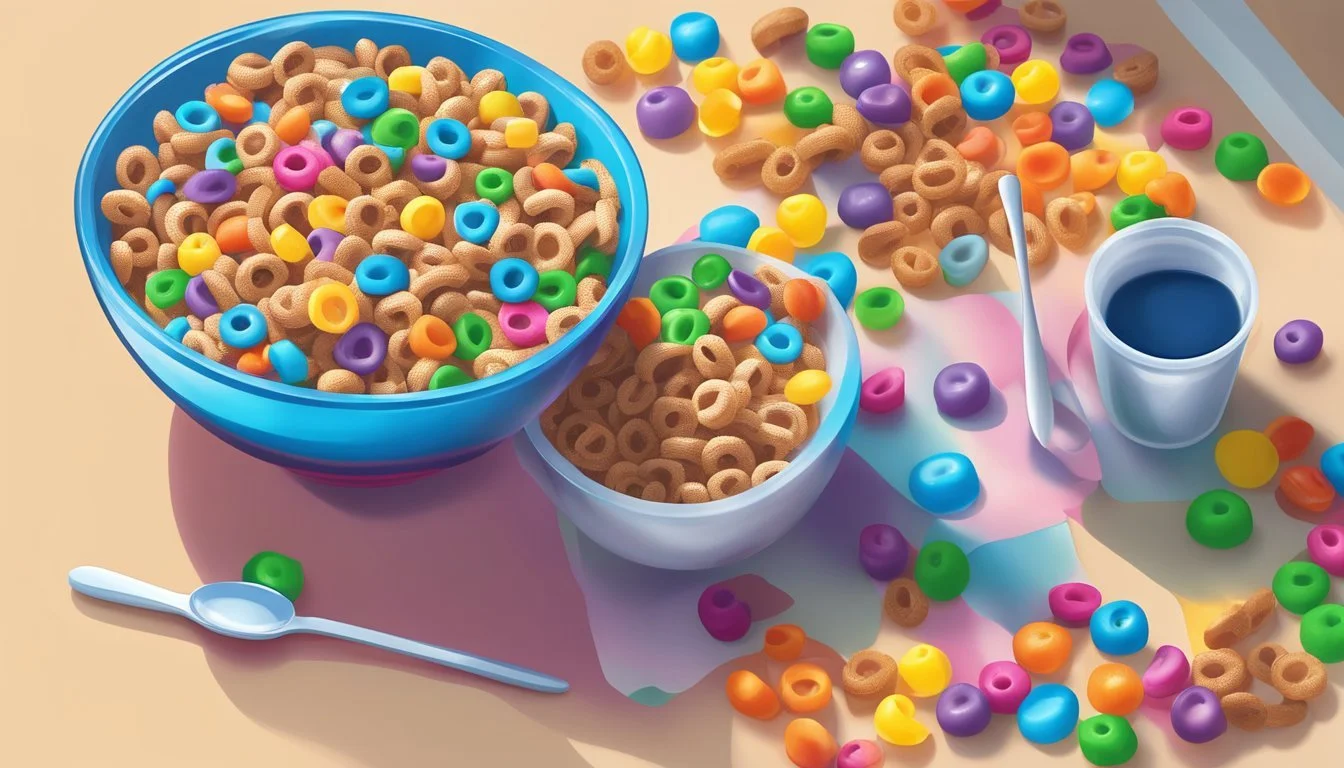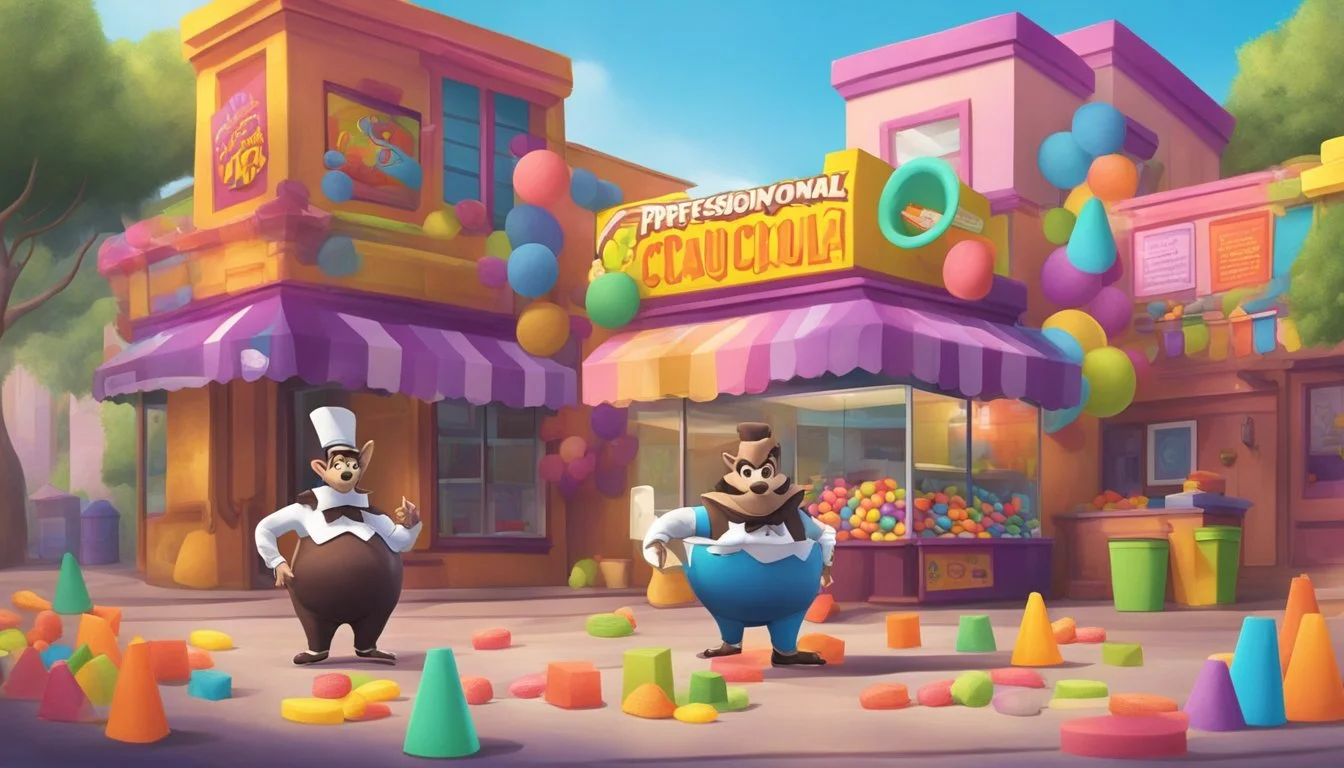Count Chocula vs Kellogg's Froot Loops
Breakfast Cereal Showdown Analysis
This Article is Part of Our Breakfast Cereal Guide with Details on Count Chocula Nutrition and Kellogg's Froot Loops Nutrition
Breakfast cereals have long been a staple in many households, and two popular choices are General Mills' Count Chocula and Kellogg's Froot Loops. When comparing their nutritional content, Count Chocula offers 79% more zinc, while Froot Loops provides double the amount of Vitamin C. These differences highlight distinct nutritional benefits depending on what one might prioritize in their diet.
Count Chocula, part of General Mills' monster cereals lineup since 1971, appeals to those with a taste for chocolatey flavors and the comforting nostalgia of classic cartoon mascots. On the other hand, Froot Loops, recognized for its vibrant, fruit-flavored rings and iconic Toucan Sam, has been a favorite among children and adults alike since its inception after the discontinuation of another Kellogg's cereal.
Understanding these cereals' nutritional profiles and histories helps consumers make informed breakfast choices, catering to personal dietary needs and flavor preferences. This detailed look at Count Chocula and Froot Loops will shed light on which of these breakfast staples might best suit your morning routine.
History and Brand Overview
Count Chocula and Kellogg's Froot Loops are two iconic breakfast cereals that have captivated generations with their unique flavors and branding strategies. Each originated in a specific historical context and has undergone various changes through the years.
Origins of Count Chocula
Count Chocula was introduced by General Mills in 1971 as part of the "Monster Cereals" line. Featuring a vampire mascot, Count Chocula distinguished itself with its chocolate-flavored cereal combined with marshmallow bits.
Initially aimed at children, the cereal quickly gained popularity. The character Count Chocula, with his charming and spooky persona, became a significant marketing symbol. General Mills expanded the brand over the years by introducing seasonal variants and limited-edition releases, making it a nostalgic favorite.
The cereal continues to enjoy a loyal fan base, thanks to its enduring appeal and unique blend of flavors.
Evolution of Kellogg's Froot Loops
Kellogg's Froot Loops made their debut in 1959. Designed primarily for a younger audience, this colorful cereal featured ring-shaped pieces with fruity flavors, represented by its cheerful mascot, Toucan Sam.
Created after the discontinuation of Kellogg's OKs cereal, Froot Loops offered a vibrant, fruit-flavored alternative. The product's bright colors and catchy advertising campaigns quickly resonated with consumers.
Kellogg's has maintained the appeal of Froot Loops by introducing new flavors and variations, keeping the product relevant to contemporary tastes. The brand is now marketed under WK Kellogg Co in the U.S., Canada, and the Caribbean, following a corporate restructuring in 2023.
Nutritional Profiles
Count Chocula and Kellogg's Froot Loops vary significantly in their nutritional profiles. This section provides an in-depth comparison of their macronutrient content, vitamin and mineral levels, and their sugar and fiber composition.
Macronutrient Comparison
Count Chocula contains 120 calories per serving, whereas Kellogg's Froot Loops has 110 calories per serving.
Protein content is higher in Count Chocula, offering 2 grams per serving, compared to Froot Loops' 1 gram. Both cereals contain a similar amount of fats, with Froot Loops at 1.0 gram and Count Chocula at 1.5 grams.
Carbohydrates are the dominant macronutrient in both, with Froot Loops containing 25 grams and Count Chocula slightly more at 27 grams per serving.
Nutrient Count Chocula Froot Loops Calories 120 110 Protein (g) 2 1 Fat (g) 1.5 1.0 Carbohydrates (g) 27 25
Vitamin and Mineral Content
Kellogg's Froot Loops is notably richer in Vitamin C, offering 52 mg per serving compared to Count Chocula's 22.2 mg.
Count Chocula, on the other hand, excels in Zinc content, providing 79% more than Froot Loops. Additionally, Count Chocula generally contains more Vitamin B12, Vitamin D, and Iron, contributing to its nutritional profile.
Froot Loops is fortified with a significant amount of Vitamin A, Calcium, and Folic Acid, supporting various aspects of health.
Sugar and Fiber Analysis
Sugar content in both cereals is high. Count Chocula has slightly less sugar, with 12 grams per serving compared to Froot Loops’ 13 grams.
Fiber content is another important aspect. Both cereals offer 2 grams of dietary fiber per serving, which aids in digestion and provides a sense of fullness.
Maintaining a balanced intake of these cereals while being mindful of their sugar content is essential for a healthy diet.
Ingredient Composition
Count Chocula and Kellogg's Froot Loops differ not only in taste but also in their ingredients. This composition affects their nutritional value and potential health impact.
Main Ingredients
Count Chocula primarily uses a Corn Flour Blend, Whole Grain Oat Flour, and Wheat Flour. These grains provide the base for this chocolate-flavored cereal. It also includes Oat Fiber to enhance its fiber content. The use of Vegetable Oil (such as soybean and cottonseed oils) is notable for maintaining texture and richness.
Kellogg’s Froot Loops, on the other hand, primarily uses Corn Flour Blend combined with Wheat Flour. Additionally, it incorporates Soluble Corn Fiber to bolster fiber content. Essential elements like Salt and Natural Flavor are common to enhance flavor, though the balance and application differ from Count Chocula.
Additives and Coloring
Count Chocula includes BHT (to preserve freshness), as well as food colorings such as Red 40 and Blue 1. The artificial colors serve to make the cereal visually appealing to children and adults alike.
Froot Loops utilizes a broader spectrum of food colorings: Red 40, Yellow 5, Yellow 6, and Blue 1. These contribute to its distinctive, bright, and varied colors. Like Count Chocula, Froot Loops also uses BHT, and it's fortified with additional vitamins and minerals, including notably high levels of Vitamin C compared to Count Chocula.
Dietary Considerations
Count Chocula and Kellogg's Froot Loops differ notably in their nutritional profiles. These differences have implications for individuals with specific dietary needs, such as those requiring low-fat, low-carb, low-calorie, or low glycemic index foods.
Allergen Information
When it comes to allergens, Count Chocula contains wheat, which may be problematic for those with gluten sensitivity or celiac disease. Additionally, it may contain traces of soy and milk.
Froot Loops, produced by Kellogg's, list wheat, corn, and soy as ingredients. People with gluten intolerance and soy allergies should be wary.
Both cereals may also contain artificial coloring agents that can cause reactions in sensitive individuals. Always read labels carefully to avoid inadvertent exposure to allergens.
Diet Recommendations
Count Chocula is higher in sugars but offers some fortified vitamins and minerals. It's suitable for neither low-carb nor low-sugar diets due to its composition.
In contrast, Froot Loops has a higher vitamin C content but also comes with significant sugar levels. Both cereals aren’t ideal for low-carb or low-glycemic index diets.
If following a low fats diet, both cereals are generally low in fat. However, their high sugar content makes them a less desirable option for low calories or low glycemic index diets. Those focusing on nutrient density over caloric intake should consider these aspects.
Market Positioning
Count Chocula and Kellogg's Froot Loops are both iconic cereals with strong market identities shaped by their pricing strategies and memorable brand mascots.
Pricing Analysis
Count Chocula, produced by General Mills, is often positioned as a reasonably priced cereal within the market. It typically ranges between $3.50 to $4.50 per box. This positions it competitively against other cereals like Cheerios and Frosted Flakes. Kellogg's Froot Loops usually commands a slightly higher price point, ranging from $4.00 to $5.00 per box.
Seasonal pricing variations occur, particularly around holidays when Count Chocula might be specially marked or bundled with other General Mills products. Froot Loops also features promotions, but these tend to be focused on family packs or special edition boxes.
Brand Mascots
Count Chocula leverages its spooky vampire mascot, with a voice originally by Mel Blanc and later by Maurice LaMarche, to appeal to children and nostalgic adults. The character's playful and slightly ghoulish persona has helped solidify its place among themed cereals.
Kellogg's Froot Loops is represented by Toucan Sam, a colorful toucan known for his enthusiastic catchphrase, "Follow your nose!" Voiced by various actors over the years, including Maurice LaMarche, Toucan Sam’s memorable antics and colorful design make the cereal easily recognizable.
Both brands use their mascots extensively in marketing and advertising, ensuring a strong visual and emotional connection with their consumers, but focusing on different thematic elements to capture their audience’s attention.
Consumer Experience
Count Chocula and Kellogg's Froot Loops offer distinct experiences influenced by their taste, texture, color, and appearance.
Taste and Texture
Count Chocula provides a rich chocolate flavor paired with a light, crunchy texture. The cereal pieces are airy, making them easy to bite into.
In contrast, Froot Loops delivers a fruity taste derived from a blend of artificial fruit flavors. This cereal has a denser texture, offering a more robust crunch.
Consumers often note that Count Chocula's chocolate can be initially overwhelming but mellows out with milk. Froot Loops maintain their sweetness, which some find cloying over time.
Both cereals soften in milk but retain enough texture to avoid becoming mushy quickly.
Color and Appearance
Count Chocula is primarily brown, reflecting its chocolate content. The cereal also includes marshmallow pieces shaped like bats and ghosts, adding a playful element to its appearance.
Froot Loops, on the other hand, are famous for their vibrant colors. Each loop is a different color, including red, yellow, orange, green, blue, and purple. Despite their varied appearance, every color tastes the same.
The vivid colors of Froot Loops can be appealing, especially to children. Meanwhile, Count Chocula's theme aligns well with its branding, making it a favorite during Halloween.
Both cereals aim to stand out on the shelf through their unique visual presentations.
Health and Safety
Count Chocula and Kellogg's Froot Loops are popular cereals with differing nutritional profiles, especially concerning vitamins and minerals. It's crucial to understand the health implications of the ingredients and additives in these cereals.
Regulations on Food Additives
Hydrogenated Vegetable Oil: Found in some cereals, this oil can contain trans fats, which are linked to heart disease. It's essential for consumers to check labels, as partially hydrogenated oils might still be present despite regulatory efforts to reduce or eliminate them.
Zinc Oxide and Vitamin A Palmitate: Commonly added for nutrient fortification. Zinc oxide contributes to immune function and cellular metabolism. Vitamin A palmitate supports vision and immune health. Consumers should be aware of daily intake limits to avoid excessive consumption.
Ascorbic Acid: Also known as Vitamin C, ascorbic acid is often added to cereals like Froot Loops. It’s important for collagen synthesis and acts as an antioxidant. It helps enhance the absorption of iron from plant-based foods.
Carcinogenic Concerns: Ingredients like hydrogenated oils have been scrutinized for their potential carcinogenic effects. While current formulations comply with safety standards, staying informed about ingredient changes is prudent.
Regulations ensure these additives meet safety standards, but consumers should remain vigilant about their intake and the evolving science regarding these substances.
Comparative Analysis
General Mills Count Chocula and Kellogg's Froot Loops offer distinct differences in their mineral and vitamin content. Understanding these differences can help consumers make informed choices based on their nutritional needs.
Mineral Comparison
Count Chocula surpasses Froot Loops significantly in calcium content, with a substantial 370mg compared to Froot Loops' 10mg. Such a difference could be crucial for individuals looking to boost their calcium intake for bone health.
Both cereals contain zinc, but Count Chocula provides 79% more. Zinc is essential for immune function and cellular metabolism. There is no available comparison for manganese or selenium from the provided data. Consumers concerned with comprehensive mineral intake should always check the most current packaging or manufacturer’s details.
Vitamin Comparison
Count Chocula and Froot Loops have variations in their vitamin content as well. Specific data on Vitamin A RAE, essential for vision and immune function, was not provided. Consumers should refer to packaging for detailed values. Both cereals typically include a range of basic vitamins and are fortified to meet daily requirements, but differences can be significant depending on the brand and formulation changes. For accurate and up-to-date nutrient information, always refer to the latest product labels.
More on Count Chocula
More on Kellogg's Froot Loops
Cinnamon Toast Crunch vs Kellogg's Froot Loops: Which is better?
French Toast Crunch vs Kellogg's Froot Loops: Which is better?
Honey Nut Cheerios vs Kellogg's Froot Loops: Which is better?
Kellogg's Apple Jacks vs Kellogg's Froot Loops: Which is better?
Kellogg's Froot Loops vs Post GrapevsNut Flakes: Which is better?
Kellogg's Froot Loops vs Post Raisin Bran Cereal: Which is better?







